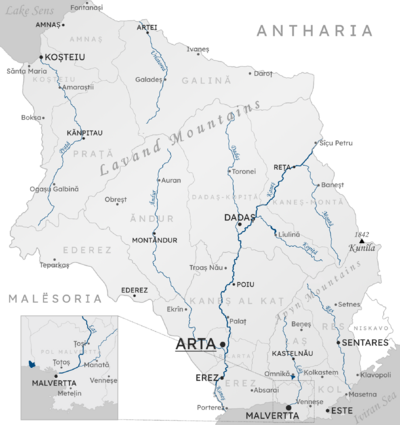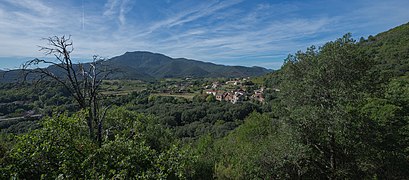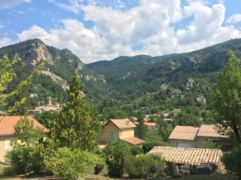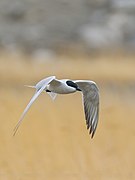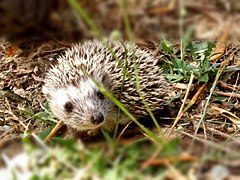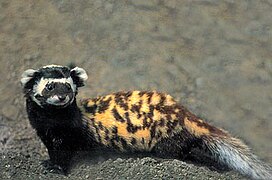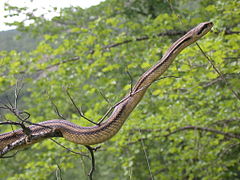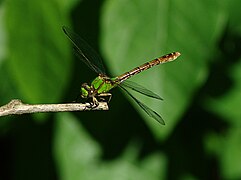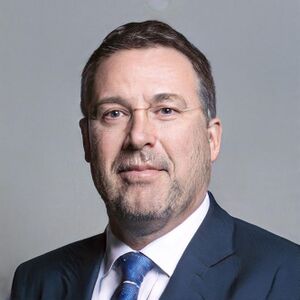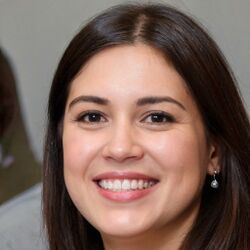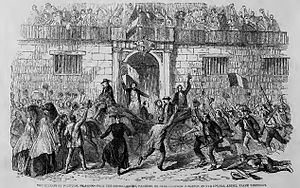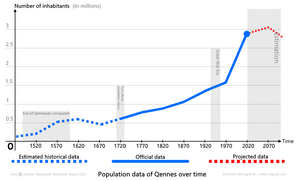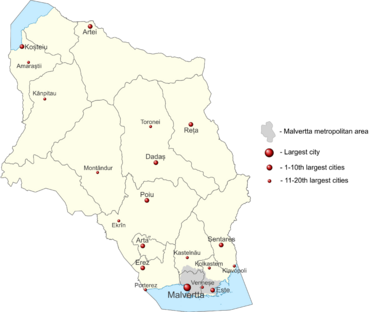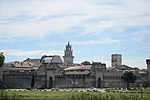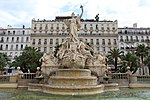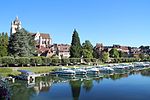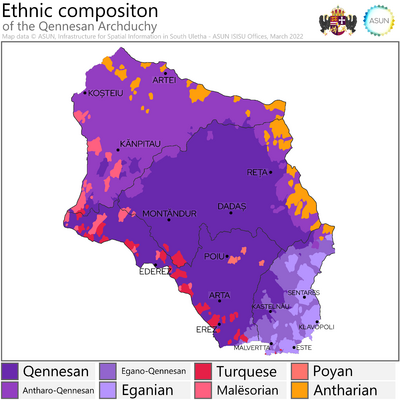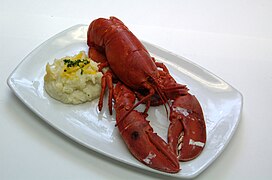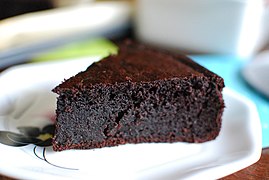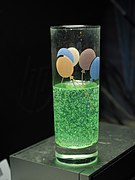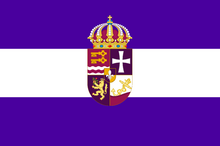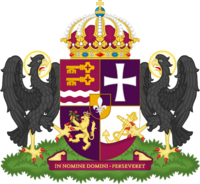Qennes: Difference between revisions
Bixelkoven (talk | contribs) |
Bixelkoven (talk | contribs) |
||
| Line 279: | Line 279: | ||
[[File:QennesPM.jpg|thumb|250px|right|The current prime minister Agoța Bedreș, leader of the Liberal-Green Action party.]] | [[File:QennesPM.jpg|thumb|250px|right|The current prime minister Agoța Bedreș, leader of the Liberal-Green Action party.]] | ||
=== Legislature === | === Legislature === | ||
[[File:Palermo 1860 release of political prisoners.jpg|thumb|left|300px|''Folie et ravages à la Maison nationale de l'archiduché d'Arta, 27 juillet 1824'' by Antoine Yves Laurette.]] | |||
The legislative branch of the Qennesan government is characterized by a bicameral parliament, and a separate special religious body, being the Royal Ekelan Church of Qennes that operates independently from the government of Qennes, and works within its own special monastic jurisdiction in eastern Qennes. | The legislative branch of the Qennesan government is characterized by a bicameral parliament, and a separate special religious body, being the Royal Ekelan Church of Qennes that operates independently from the government of Qennes, and works within its own special monastic jurisdiction in eastern Qennes. | ||
| Line 288: | Line 289: | ||
=== Executive === | === Executive === | ||
The heads of the executive branch are the archduke (or archduchess) (''arkiduṣ/arkiduṣîță'') and the head of the parliament, that being the prime minister of Qennes. Despite being the head of the executive branch, the archduke does not possess any significant power in comparison to the prime minister. The archduke is elected by the Nobility and the Ekelan Church, and has a maximal ruling timespan of 40 years, but can be elected as many times as possible. At the time of the establishment of the elective monarchy, 40 years was considered as the satisfactory amount of years for an individual ruling span, considering the average lifespan of a human being rather low. Nowadays, however, the life expectancy increased substantially, but the ruling term limit was never changed. There have been several debates to remove the 40 years ruling limit, or to increase it to a higher number. | The heads of the executive branch are the archduke (or archduchess) (''arkiduṣ/arkiduṣîță'') and the head of the parliament, that being the prime minister of Qennes. Despite being the head of the executive branch, the archduke does not possess any significant power in comparison to the prime minister. The archduke is elected by the Nobility and the Ekelan Church, and has a maximal ruling timespan of 40 years, but can be elected as many times as possible. At the time of the establishment of the elective monarchy, 40 years was considered as the satisfactory amount of years for an individual ruling span, considering the average lifespan of a human being rather low. Nowadays, however, the life expectancy increased substantially, but the ruling term limit was never changed. There have been several debates to remove the 40 years ruling limit, or to increase it to a higher number. | ||
The archduke has the power to propose and suggest a candidate for any minister position, and has a single vote along with the other members of the parliament, but has no power to solely appoint anyone for the positions. The archduke enacts all laws passed by the Peasantry Union. Together with the Nobility, they appoint the final member of the lower house. | The archduke has the power to propose and suggest a candidate for any minister position, and has a single vote along with the other members of the parliament, but has no power to solely appoint anyone for the positions. The archduke enacts all laws passed by the Peasantry Union. Together with the Nobility, they appoint the final member of the lower house. | ||
Revision as of 18:30, 6 January 2023

|
The Qennesan Archduchy Arkiduțiă Kaneșului (Qennesan) Archidoucatul Quenneʃ (Romanish) Arkidukat Kenes (Eganian) Kanıs Arşidüklüğü (Turquese) Kryedukati i Kenes (Malësorian) Arȿiḏucijȁ Ḵenɘs (Poyan) Capital: Arta
Population: 2,856,380 (2022) Motto: Iața Kaneșienii Anthem: Frumosă noastră ḑintre Lină Tîrdau șî Mar Iviran |
Loading map... |
Qennes (/kɛnes/, pronounced: KE-nes; Qennesan: Kaneș, pronounced: [känɛʂ], KA-nesh), officially The Qennesan Archduchy (Qennesan: Arkiduțiă Kaneșului), is a sovereign state in central-southern Uletha∈⊾. It is bordered by Malësoria to the west, Antharia to the north and east, and Niscavo to the southeast. It also borders the Demirhan Empire to the south via the Bay of Erez, part of the Iviran Sea∈⊾ on which Qennes has its southern shores, while the northwestern shores are located on the Lake Sens∈⊾. The capital city is Arta located in the southwest of the country, while the largest city is Malvertta.
Originally an area inhabited by various tribes of many origins, most notably the Moorsh, but also the Kartlegian, Malesor, Po'ion, Semic and Slevic people groups, Qennes emerged from the remnants of the Hellanesian colonial period in the Iviran Sea region as a duchy in the 2nd century AD. It encompassed the coastal regions of modern Qennes centered around the cities of Molokortia and Erulgi (modern day Malvertta and Porterez, respectively) which dominated the cross-Ulethan trade flow in the region. Until the 15th century, Qennes' boundaries would constantly change under various conquests and wars. Eventually the Eganian nations to the east would take over the Qennesan coast and push it inland. With the beginning of the 15th century, the Qennesan duchy gained a large influential presence of the Romanish culture, which would completely reshape the Hellanesian-influenced culture of Qennes. In 1427, led by duke Aleksandru I Poraș 'the Stalwart', a new Qennesan nation was born and a new national identity. Aleksandru would triple the size of his nation and reform his title into an archduke.
In the late 18th century Qennes would see itself transform into an elective monarchy from an absolute one, after the Rebellion of Artei. It went through the revolutionary, rennaisance, industrial and Great War eras with its lands mostly intact, with an emphasis on economic growth, with its independence guaranteed and protected by the Antharian Kingdom for most of the timeline. It entered the 20th century as a very unequal country in terms of individual economic power and a population half its size nowadays. Pushed by industrialization, and later the modern socio-economical revolution, Qennes rose to being one of the wealthiest nations globally. Nowadays, Qennes is an elective monarchy ruled by an archduke, a developed and high living standard country with a high-income, mixed market economy. It is a member of the Association of South Ulethan Nations, after joining in 19xx, and has signed numerous agreements with its neighbors and beyond. Qennes has a population of about 2.85 million people which is spread out on 9,846 square kilometers, making it one of the most densely populated countries in both south Uletha and the whole world.
Etymology
The name Qennes is the Ingerish version of the native name Kaneș. The name 'Qennes' gets its roots from the Romanish name for the coastal area west of Niscavo - Quenneʃ.
Kaneș, as a name, has no certain etymology although there are two possible answers. During the Hellanesian colonization of the coast west of Niscavo, the area was uninhabited upon arrival. It is thought that the colonizers named the region Keno, Kene, Kenos or either Kenes, all of which derive from the Hellanesian word keno, meaning "empty". It is considered that the name eventually became the name of the Hellanesian subdivision in the area.
Another suggestion is that the name was derived from the phrase 'Kan nisi' , which means "possibly an island" in Hellanesian. It is thought that the colonizers have mistaken the peninsula in nowadays Malvertta for an island, or were either uncertain if it is either of the two.
The name Kaneș was first recorded in 1427 when Qennes' borders where roughly at the lines with nowadays Lipămontală∈⊾ province. Before that date, Qennes was known as 'Kenes' by the Hellanesians, 'Quenneʃ' by the Romanish and 'Kanis' by the Turquese. Since 1427 the name has remained unchanged.
History
Prehistory
Early history
Hellanesian colonization era
Independence years
Post-Independence years
Darazdinian state
Antharian Kingdom
Medieval Era
Anagenisi Period
Romanish invasion
Neo-Hellanesian colonization era
Early modern era
Great War era
Modern era
Geography
 | |
|---|---|
| Geography of Qennes | |
| Continent | Uletha (Western) |
| Region | Iviran Coast |
| Population | |
| Area | |
| • Total | 10,363.18 km2 4,001.25 sq mi |
| • Water (%) | 6.68% |
| Population density | 275.63 km2 713.87 sq mi |
| Extreme points | Kunîla (1842 m) Iviran Sea∈⊾ (0 m) |
| Longest river Largest lake (by area) | Kaneș (x) Lake Omnikă (Lină Omnikă) (x) |
| Time zone | WUT +5 |
Qennes is situated on the continent of Uletha, in its central-southern region known as the Iviran Coast, by the Iviran Sea∈⊾. It lies between latitudes 41° and 40° N, and longitudes 83° and 84.5° E. The geographic center of Qennes is located west of the city of Dadaș, on the AP-3 highway, at the coordinates of 40.2462° N and 83.719° E, near the village of Brațaș.
Qennes is a moderately hilly nation, with two major mountain chains spanning east to west. They are the Lavand Mountains in the central areas of the country and the Apyn Mountains in the southeast, both of which span east into Antharia and Niscavo. The tallest peak, Kunîla, standing at 1842 meters, is located in the Apyn Mountains range on the tripoint of the municipalities of Kaneș-Montă∈⊾, Res∈⊾ and the country of Antharia. Most of the country is dominated by rolling hills, river valleys and flat plains. The three major plains in Qennes are the Koșteiu Plain, the Erez Plain, home to most of the agriculture activity, and the Qennesan Riviera Region - the most densely populated area in the country, as well as a tourist hotspot. The lowest point of Qennes is the Asperic Ocean at sea level (0m), with no stretches of land under sea level.
- Landscapes of Qennes
Lavand Mountains near Liud, Dadaş - Kopiță
Montă river valley, Kaneș - Montă
Massif near Ogașu Galbină, Prață
Filin mountain near Manastîr Valas, Kaneș - Montă
Coastal area near Plaẓa Ketne, Este
Salterns in Viletta, Erez
Geology
Qennes is in a semi-active seismic zone. It lies near the active convergent boundary of the Asperic and East Ulethan plates.[1] There have been at least 50 destructive earthquakes in the past identified by scientists. There are numerous caves throughout Qennes, found throughout the hilly and mountainous regions of the country. In the Feră Empodia region, grottoes are a dotted along the cliffs. There are about 70 grottoes in Qennes. The rock composition is predominantly sedimentary, and the soil is favorable for year-round agricultural activity in every part of the country.
|
| ||||||||||||||||||||||||||||||||||||||||||||||||||||||||||||||||||||||||||||||||||||||||||||||||||||||||||||||||||||||||||||||||||||||||||||||||||||||||||||||||||||||||||||||||||||||||||||||||||||||||||||||||||||||||||||||||
Climate
As a rather small sized country, Qennes doesn't pose much diversity in climate. There are 2 climate zones in Qennes: 'Csa' encompasses most of the country, while the highest of mountains and peaks are classifed as 'Csb'. Qennes is characterized by dry summers and mild, wet winters.
The precipitation rate varies between 35mm and 94mm year round. The rainfall rarely exceeds 150mm during a month, and the average amount of rainfall is 64mm. Qennes receives about 3,712 hours of sunshine year round, with the numbers peaking at 384 hours in July. Such a climate has allowed Qennes to develop into a highly popular summer tourism destination.
Waters
All of Qennes' rivers belong to the Iviran Sea∈⊾ basin. They are either directly part of the drainage basin, or part of the Lake Sens∈⊾ drainage basin, which empties into the Iviran Sea via the Recz River in Antharia.
The longest river is the Kaneș River with a length of XXXm (XXXm of which is within the borders of Qennes). It has it source near the monastery of Pakras in western Antharia, flowing southwest towards the Bay of Erez where it meets the Iviran Sea next to the town of Porterez. On its course it flows through a few major cities and towns including Kallomenos (Antharia), Reța, Dadaș, Poiu, Arta, Erez, Porterez (Qennes) and Portilumës (Malësoria). Qennes has a low number of natural lakes and ponds. Besides the Lake Sens, the largest natural lake would be Lake Omnikă in the south of the country, created by a natural phenomenon of beavers constructing a dam on the Omnikă River strong enough to dam the small river. This enabled engineers to find the perfect spot for a dam.
Other natural lakes can be mainly found in the southwest, precisely oxbow lakes created by the Kaneș River and its meandering. The largest lake, besides the Lake Sens, is the Lîulină Reservoir, created artificially by the Lîulină Dam on the Kopiță River.
Biodiversity & Protected Areas
Qennes has a wide number of animal, plant and fungi species present in its territory. It is one of the most biodiverse countries in southern Uletha, proportional to its territory size. In 1998, Qennes brought a Biodiversity Recognition law into power, which revised the biodiversity situation in the country and set to protect endangered species, and control the human usage of natural resources of the nature. Alongside that, Qennes redefined its protected areas.
There are 3 main terrestrial biogeographical and eco-regions: Littoral, Lower Continental and Upper Continental. The Littoral regions is dominated by the Mediterranean biome, mainly hot and dry summers, and rainy and semi-rainy winters, forests and shrubs of lower density, plants which can be pyrophytes, numerous cases of the "mosaic habitat" and general drier scenery. It is found along the coast of Qennes, forming a belt of maximum 5km in width. It is by far the smallest of the three regions.
The Lower Continental regions are located at lower lying areas throughout continental Qennes, mainly among the elevating range between 150 and 800 meters. It is characterized by a semi-drier climate, a more denser vegetation rate, higher density of animal species, and lower amount of mosaic habitats. It is a transition zone between the much drier Littoral and the less drier Upper Continental. Numerous and larger oak and beech forests, garrigues (phryganas), matorrals and other types of shrubs can be found here. The zone has the highest average temperature among the three areas, the lowest rainfall and therefore the highest chance of catching natural wildfires, but also man-made forest fires, which can happen during the stubble burning season in rural areas, since this zone account for 80% of the agricultural activity in the country. Stubble burning is often considered a problem of the past, however is still present in northern and eastern regions of the country.
The Upper Continental regions are located at the highest of elevations in the country, everything above 800 meters. It is dominant in denser forests and woodlands, less so in shrubs and bushes. It includes forests of oaks, pines, conifers, and maqius shrublands. It presents a larger precipitation rates compared to the Lower Continental regions, but also lower temperatures, the lowest in the country. The tallest peaks often have temperatures below zero during winter and early spring. These regions see minimal agricultural activity but the largest forestry activity amongst the three. It accounts for about 70% of Qennes' forested areas, and since the 1998 law, the area size of the forested lands has increased drastically, as numerous tree-planting activities were introduced to preserve and increase the forested lands. Qennes is still however one of the least forested nations in Uletha proportional to its size.
Flora & Fauna
Qennes has a wide variety of plants and animals which are found in the whole of south Uletha. Dominant tree types include: oaks, pines, conifers, beech, olive trees, palms, fig trees, holm oaks, cork oaks, chestnuts, grapevines, magnolias, ficus trees, Curtisia, etc. A notable species of trees prevalent in Qennes are the 'Red Robin' trees. Among other plants, Qennes is home to the: flowering ash, Gleditsia, Jujube, grey elms, Pompia, azeroles, hawthorns, matorral, garrigue, maqius, etc. Traditional crops include: grapes, olives, figs, pomegranates, oranges, apricots, lemons, tangerines, and others, mainly grown for commercial purposes and exports, alongside typical crops like wheat, corn, barley, various vegetables, fruits and nuts which are mainly for domestic consumption.
Animals prevalent in the region can be found in Qennes as well. There are about 100 animal species, and they include: various sponges, corals, sea anemones, starfishes, sea cucumbers, sea snails, sea worms, octopuses, jellyfish, and a noticeable amount of crabs (which gave the name of the region in southeast Qennes and Niskavo - Klavia/Niskavo), lobsters and prawns - for the sea ecoregion. Terrestrial animals include: durmouses, mouses, rats, shrews, voles, bats, wolfs, chamois, deers, dolphins, snakes, lizards, butterflies, dragonflies, Praying mantises, cicadas, glow-worms, hawk-moths, stinkbugs, crickets, hornets, wasps, bees, beetles, toads, salamanders, newts, turtles, ray-finned fish, eels, carps, various other fishes, and various domesticated animals like horses, cows, sheep, goats, pigs, etc. The common yellow swallowtail butterfly and the green snaketail dragonfly are the national animals of Qennes.
- Animals of Qennes
Protection
There are a total of X[2] protected areas in Qennes. There are 6 protection categories for areas and 4 for the protection of members of the Qennesan flora & fauna. They are:
- Protection classes for areas, highest level of protection to lowest:
- Geopark - A large unified protected area that advances the protection and use of geological heritage in a sustainable way, and promotes the economic well-being of the people who live there. Example: Geopark "Lipămontală - Lavand" (Shared with Antharia)∈⊾
- Zona Asțîra ḑe Proteḑat (ZAP) - A zone of strict protection laws. Encompases a natural habitat of animals, plants and natural features that are rare or valuable. Example: TBD
- Park Național Proteḑat (PNP) - National park network of areas with special features worthy of protection. Unlike national parks in most other countries, in Qennes they can be much smaller. Example: PNP "Feră Selandină"∈⊾
- Zonă Pitoreaskă și a Vieții Sălbatike (ZPVS) - A zone of natural beauty and/or wildlife with special protection laws. Example: "Meandre ḑe Erez"∈⊾
- Zonă Istorikală (ZI) - A zone of historic importance, usually encompassing a district within a locality. Example: Forț ḑe Erez (Erez Fortress)
- Monumenț Istorikal (MI) - A single or group of objects or structures of historical importance. They can be located within other types of protected areas. Example: Ekilița ḑe Sîc̣i Tomas ḑin Artei (Saint Thomas Church in Artei)
- Protection classes for individual flora and fauna species:
- National animal / National plant - Species of symbolic meaning which may or may not be under preservation, but has a national-wide symbolism representing the nation of Qennes. Example: Qennesan lavender (Lavandula cenesis)
- Local or endemic species under the Threatened status - Species originating in Qennes or the Iviran Coast region, that are considered as threatened of extinction. Example: Green Snaketail Dragonfly (Ophiogomphus cecilia)
- Worldwide species under the Threatened status - Worldwide species present in Qennes, that are considered as threatened of extinction. Example: Tonenian Emerald Dragonfly (Somatochlora borisi)
- Species of cultural symbolism - Species of cultural symbolism of the Qennesan regions. Example: Ulethan Green Crab in the region of Klavopoli and Niscavo. (Carcinus maenas)
Government & politics
| Government of Qennes | |
|---|---|
| Parliamentary semi-constitutional elective monarchy | |
| Capital | Royal Seat of Arta∈⊾ |
| Head of state | |
| • Archduke (Qennesan: Arkiduṣ) | Maksim III Luțian Maran |
| • Prime minister | Agoța Bedreș (LAV) |
| Legislature | Parliament of Qennes (Qennesan: Parlamentul Kaneșului) |
| • Upper house | The Nobility (Qennesan: Nobiļimiea) |
| • Lower house | The Peasantry Union∈⊾ (Qennesan: Unii Țărăņimii) |
| Judiciary | The National Courthouse of Qennes∈⊾ |
| High Noble Leader of the Peasantry | Ursa II Ilionesku Damon Fionesku (KP) |
| Elections in the Nobility Elections in the Peasantry Union The Peasantry Union last election The Peasantry Union next election | None 1913-1964: Abraham-Fink's Method 1964-present: Proportional representation Every 5 years 15 July 2019 8 January 2024 |
Major political parties | |
Government (83) LAV (49)
KP (21)
US (13)
Government support (2) MKE (1)
MKAD (1) Opposition (71)
DSK (26)
LD (5)
AE-RO (3)
H! (2)
MM (1)
A (11)
KKR (7)
KSK (6)
IRN-KAgr (5)
KSO (3)
MLZ (1)
MKPA (1) | |
| AN, ASUN, SUECC | |
The government of Qennes is defined by the Royal Constitution of 1913, signed in Artei. It notes that Qennes is a semi-constitutional parliamentary electoral monarchy ruled by an archduke as the head of state, with Maksim III Maran presently on the throne since 2015. Qennes was for the entire course of its existence a monarchy (duchy), since the year 176 AD. Until 1787 it was an absolute monarchy, with all power concentrated on the head of state. In 1427, the government was reformed into an archduchy by Aleksandru II Poraș, considered the greatest ruler in the nation's history.
In 1787, the Rebellion of Artei occured after the rising concerns of the absolute rule of the monarchs. This event brought the end to the absolutist rule of the royals and established an elective monarchical rule. Historically, the parliament was created in 1009, the National House of the Archduchy (Kasă Națională ḑe Arkiduțiă) consisting of the Nobility and the Peasantry, each representing their own social class. Although the Nobility was more powerful than the Peasantry, both houses had very little power in comparison to the ruler. Between 1787 and 1913 the Nobility was the most dominant representative house which kept the rulers' powers relatively high. Since 1913 with the final and current constitution in place, the Peasantry remains the most powerful house, with the archduke having a merely ceremonial role with very few powers.
Qennes has been nowadays described as a consociational state, and manages to have a very good democratic and representative power sharing with its many ethnic and religious groups. It ranks high in the global democracy ratings, however it still faces some problems regarding the influence of royal families. Protests and petitions to completely remove the hereditary influence from the government and to remove the monarchical rule are not uncommon.
Legislature
The legislative branch of the Qennesan government is characterized by a bicameral parliament, and a separate special religious body, being the Royal Ekelan Church of Qennes that operates independently from the government of Qennes, and works within its own special monastic jurisdiction in eastern Qennes.
The upper house of the parliament is consisted of the Nobility representatives (Nobiļimiea). Its members are representatives of royal families, which keep their representative seats forever. Any royal family may obtain a seat after all current members approve the joining. Similarly, any royal family may have their seat removed in the same fashion. Currently there are 21 royal families represented. Generally, each family represents one municipality in the government, but there have been cases when a municipality had no representatives at all. Each family may have up to 3 representatives, however during votes each family has only one vote power, regardless of the amount of members of the family. Generally, the representatives are the eldest family members. Nowadays, the upper house has little power, and its role is advisory and ceremonial. The members can veto any law or bill passed on from the archduke, they can propose law changes and bills to both the archduke and the lower house, can propose modifications to laws, but cannot enact them. Most notably, only members of the Nobility may partake in the royal elections for the throne, and the members themselves vote for the successor (along with the archbishop and bishops of the Ekelan Church).
The lower house of the parliament is the Peasantry Union (Unii Țărăņimii). It is the main and most powerful legislative body in the government and is in charge for almost all of the law passing and changes. It can create requests for laws or receive them from the archduke or the Nobility, and also pass, modify or veto them through majority voting and debates. It also has the power to elect the head of the parliament and appoint ministers in the executive branch. All but one members are decided in the national parliamentary elections, with the final member being appointed by the Nobility and the archduke who generally advocates for the interests of the Nobility, but generally has no voting power, unless a law proposal reaches the 50-50 mark in the voting stage, when the royal representative can vote for or against the bill. A member can be part of a political party or an independent member. For political parties, the minimal electoral threshold for entering the parliament is 2.5%, and 0.01% for minority parties. The elections are held every 5 years.
Executive
The heads of the executive branch are the archduke (or archduchess) (arkiduṣ/arkiduṣîță) and the head of the parliament, that being the prime minister of Qennes. Despite being the head of the executive branch, the archduke does not possess any significant power in comparison to the prime minister. The archduke is elected by the Nobility and the Ekelan Church, and has a maximal ruling timespan of 40 years, but can be elected as many times as possible. At the time of the establishment of the elective monarchy, 40 years was considered as the satisfactory amount of years for an individual ruling span, considering the average lifespan of a human being rather low. Nowadays, however, the life expectancy increased substantially, but the ruling term limit was never changed. There have been several debates to remove the 40 years ruling limit, or to increase it to a higher number. The archduke has the power to propose and suggest a candidate for any minister position, and has a single vote along with the other members of the parliament, but has no power to solely appoint anyone for the positions. The archduke enacts all laws passed by the Peasantry Union. Together with the Nobility, they appoint the final member of the lower house.
The Royal Cabinet (Kabineț Roial) hosts the prime minister and 2 deputy ministers. It also consists of 22 main ministries and their ministers, with several additional sub-ministries within the main ones. The prime minister has the main executive role in the government. The prime minister is the head of the Royal Cabinet consisted of various ministers, and can remove or replace a ministerial position. They are appointed by the legislature, and may be removed from that position in a popular vote in that branch. Generally, the prime minister is representing the largest political party after an election.
Judiciary
The judicial branch of the government features the system of courts in Qennes. It applies all the laws proposed and passed by the legislative branch and enacted by the executive branch in legal cases with its citizens, organizations and corporations. The court system is composed of 81 courts:
- The National Courthouse of Qennes in Arta∈⊾
- The High Courts of Cassation in Arta and Malvertta
- The Appellate Courts in Arta, Dadaș, Erez, Koșteiu and Malvertta
- The Administrative Courts in Arta, Dadaș, Erez, Koșteiu and Malvertta
- The Social Court in Malvertta
- The Labour Court in Malvertta
- The International Court in Malvertta - responsible for all cases for citizens without a Qennesan citizenship, and for companies from abroad
- The International Court Body for ASUN Countries in Malvertta
- The Commercial & Trial Courts in all municipal centers
- Local Courts in all prefectures
Political parties
Political parties were introduced in 1860, but their influences have been prominent only since 1913 with the empowering of the lower house, where they are all represented. By national law, political parties are not allowed to be affiliated with the Nobility and the royal families, however some of them do advocate in favor of the nobility. The size of the parliament has varied since its implementation, starting from just 30 seats, currently there are 156+1 seats. The electoral threshold for a political party to enter the parliament is 2.5% (0.01% for minority parties), and this number has fluctuated a lot throughout Qennes' history. As of 2019, there are 12 political parties represented in the parliament, with an additional five reserved for the five minorities of Qennes.
Historically, many dominant parties where on the centre-right, to right side of the political spectrum. Left-sided parties have grown later on with the growing concerns of workers' rights, personal freedoms and civil rights. During the late-20th century, green policies have become very crucial in the political climate of Qennes, and peaked at the beginning of the 21st century. Nowadays, green policies have become an integral part of almost all political parties of Qennes, and individual green parties are much less frequent. With the beginning of the 2020s, there has been a notable increase in right-wing parties, and a slightly growing nationalist sentiment.
| Party | Position | Ideology | Leader | Seats | International affiliation | |||
|---|---|---|---|---|---|---|---|---|
| LAV | Liberals - Green Action Liberaļii - Akțiă Viarḑe |
Center-left to center-right | Liberalism Green politics Environmentalism Pro-Ulethanism |
Agoța Bedreș | 49 / 156 rrrrrrrrrrrrirrrrrrrrrrrrrrrrrrrrrrrrrrrrrrrr |
|||
| DSK | Social Democrats of Qennes Demokrații Soțialî ḑe Kaneș |
Center-left | Social democracy Green politics |
Lană Ombruz | 26 / 156 rrrrrrrrrrrrrrrrrrrrrrrrrrrrrrrrrrrrrrrrrrrri |
|||
| KP | Citizens' Party Komă ḑe Poliţenii |
Center-right | Liberal conservatism Pro-Ulethanism Pro-Monarchy |
Damon Fionesku | 21 / 156 rrrrrrrrrrrrrrrrrrrrrrrrrrrrrrrrrrrrrrrrrrrrr |
|||
| US | Uletha Calls! Uleţă Strîgă! |
Center to center-left | Social liberalism Social democracy Pro-Ulethanism |
Ermis Terezean | 13 / 156 rrrrrirrrrrrrrrrrrrrrrrrrrrrrrrrrrrrrrrrrrrrri |
|||
| A | The Alternative Alternativă |
Right-wing to far-right | Nationalism Irredentism Ulethoscepticism |
Dorian Iuț | 11 / 156 rrrrrrrrrrrrrrrrrrrrrrrrrrrrrrrrrrrrrrrrrrrrr |
|||
| KKR | Qennesan Republican Party Komă Kaneșiană Republikană |
Big tent | Populism Anti-monarchy |
Floriana Șidrolan | 7 / 156 rrrrrrrrrrrrrrrrrrrrrrrrrrrrrrrrrrrrrrrrrrrrr |
|||
| KSK | Socialist Party of Qennes Komă Soțialistă ḑe Kaneș |
Left-wing | Socialism Ulethoscepticism Pro-Surianism |
Maria Albanoț | 6 / 156 rrirrrrrrrrrrrrrrrrrrrrrrrrrrrrrrrrrrrrrrrrrri |
|||
| LD | Democratic League Ligă Demokratikă |
Center | Democratic socialism Green politics |
Selina Ruperu | 5 / 156 rrrrrrrrrrrrrrrrrrrrrrrrrrrrrrrrrrrrrrrrrrrrr |
|||
| IRN | Back to our Roots Îndarît la Rîței Noastri |
Center | Localism Radicalism Producerism Green politics |
Euḑen Iaramăn | 5 / 156 rrrrrrrrrrrrrrrrrrrrrrrrrrrrrrrrrrrrrrrrrrrrr |
|||
| AE-RO | Economic Action - People's Revolution Akțiă Ekonomikă - Revoluție Oamiņilor |
Left-wing to center-left | Economic democracy Socialism Green politics |
Una Propileu | 3 / 156 rirrrrrrrrrrrrrrrrrrrrrrrrrrrrrrrrrrrrrrrrrrri |
|||
| KSO | Party of Saint Openge Komă ḑe Sîc̣u Openge |
Right-wing | Christic democracy Theoconservatism Pro-monarchy |
Ștefan Duruan | 3 / 156 rirrrrrrrrrrrrrrrrrrrrrrrrrrrrrrrrrrrrrrrrrrri |
|||
| H! | Come on! Haide! |
Left-wing | Progressivism Social liberalism Feminism LGBTQ+ rights |
Silvană Ukraț | 2 / 156 rrrrrrrrrrrrrrrrrrrrrrrrrrrrrrrrrrrrrrrrrrrrr |
|||
| MKE | Eganian Coalition Koaliță Eganiană <Eganian name> |
Syncretic | Minority interests | Tadeo Spiropulo | 1 / 156 irrrrrrrrrrrrrrrrrrrrrrrrrrrrrrrrrrrrrrrrrrrri |
|||
| MM | The Meeting Sinastîsa Mbledhjen |
Syncretic | Minority interests Representative democracy |
Oimir Bușati | 1 / 156 irrrrrrrrrrrrrrrrrrrrrrrrrrrrrrrrrrrrrrrrrrrri |
|||
| MLZ | Turq List Listă Zoriļor Türk Listesi |
Syncretic | Minority interests | Haluk Gokalp | 1 / 156 irrrrrrrrrrrrrrrrrrrrrrrrrrrrrrrrrrrrrrrrrrrri |
|||
| MKAD | Antharian Democratic Party Komă Antariană Demokratikă Partidul Démocrad Antharian |
Syncretic | Minority interests Representative democracy |
Ștefan Kaẓur | 1 / 156 irrrrrrrrrrrrrrrrrrrrrrrrrrrrrrrrrrrrrrrrrrrri |
|||
| MKPA | Poyan Agrarian Party Komă Poiană Agrară Guṁȁ Ɓoɟonȁ aʪ Ɗrehṅiɽ |
Center-left to left-wing | Minority interests Agrarianism Conservatism |
Iardan Trodeh | 1 / 156 irrrrrrrrrrrrrrrrrrrrrrrrrrrrrrrrrrrrrrrrrrrri |
|||
Administrative divisions
Provinces
The four provinces of Qennes are the first level of subdivision in the country, however they posses no power of their own. Their role is purely ceremonial, historical, statistical and administrative. They follow the historical borders of these regions.
| Province | Coat of Arms | Capital | Number of municipalities | Land area | Population | Population density | ||
|---|---|---|---|---|---|---|---|---|
| km² | mi² | km² | mi² | |||||
| Erez∈⊾ | Erez | 4
(Arta, Ederez, Erez, Poiu) |
2241 | 865 | 625,046 | 278 | 722 | |
| Feredetî∈⊾ | Malvertta | 4
(Este, Kastelnău, Malvertta, Sentares) |
1233 | 476 | 1,299,793 | 1,054 | 2,730 | |
| Lipămontală∈⊾ | Dadaș | 3
(Dadaş, Montăndur, Reța) |
3426 | 1322 | 387,521 | 113 | 293 | |
| Tîrdau∈⊾ | Koșteiu | 4
(Amnaş, Artei, Kănpitau, Koşteiu) |
3093 | 1194 | 544,020 | 175 | 455 | |
Municipalities
The municipalities of Qennes present the second level of administrative subdivisions, and the highest of local governance. As opposed to provinces, municipalities govern their designated area and can enact certain local laws. A municipality has a municipal president, representing the Peasantry and elected by the people; and a municipal noble, who presents a mostly ceremonial figure, and represents the municipality in the Nobility. A municipality is divided into communes and prefectures (groupings of communes under one city or town). Malvertta is the only exception, being a metropolitan city the whole municipality is categorized as one large settlement.
There are 15 municipalities, each province having 4 of them, with the exception of Lipămontală which has 3.
| Municipality | Coat of Arms | Adm. centre | Number of cities | Land area | Population | Population density | ||
|---|---|---|---|---|---|---|---|---|
| km² | mi² | inhab./km² | inhab./mi² | |||||
| Amnaş∈⊾ | Amnaş | 2
(Amnaș, Fontanași) |
505 | 195 | 60,127 | 119 | 308 | |
| Ăndur)∈⊾ | Montăndur | 3
(Auran, Montăndur, Obreșt) |
1121 | 432 | 103,430 | 92 | 239 | |
| Reḑionu Kapital ḑe Arta∈⊾ | Arta | 1
(Arta) |
125 | 48 | 76,687 | 613 | 1,597 | |
| Dadaş - Kopiță∈⊾ | Dadaş | 3
(Dadaş, Lîulină, Toronei) |
1297 | 500 | 178,504 | 137 | 357 | |
| Ederez∈⊾ | Ederez | 2
(Ederez, Teparkaş) |
609 | 235 | 52,630 | 86 | 223 | |
| Erez∈⊾ | Erez | 3
(Absarai, Erez, Porterez) |
293 | 113 | 285,061 | 972 | 2,522 | |
| Galină∈⊾ | Artei | 4
(Artei, Daroț, Galadeș, Ivaneș) |
1135 | 438 | 139,820 | 123 | 319 | |
| Kaneș - Montă∈⊾ | Reța | 3
(Baneșt, Reța, Sîc̣u Petru) |
1007 | 389 | 105,587 | 104 | 271 | |
| Kaneș al Kaț∈⊾ | Poiu | 4
(Ekrîn, Palaț, Poiu, Troaș Nău) |
1070 | 413 | 210,668 | 196 | 510 | |
| Kol∈⊾ | Este | 4
(Este, Kolkastem, Masetna, Venneșe) |
165 | 63 | 364,632 | 2,209 | 5,787 | |
| Koşteiu∈⊾ | Koşteiu | 4
(Amaraștii, Boksa, Koșteiu, Săntă Maria) |
452 | 174 | 257,565 | 569 | 1,480 | |
| Laş∈⊾ | Kastelnău | 3
(Kastelnău, Omnikă, Beņeș) |
355 | 137 | 120,872 | 340 | 882 | |
| Malvertta∈⊾ | Malvertta | 5
(Malvertta, Țoși, Țoțoș, Meteļin, Manată) |
104 | 40 | 632,131 | 6,078 | 15,803 | |
| Prață∈⊾ | Kănpitau | 2
(Kănpitau, Ogașu Galbină) |
1000 | 386 | 86,508 | 86 | 224 | |
| Res∈⊾ | Sentares | 3
(Klavopoli, Sentares, Setnes) |
605 | 234 | 182,158 | 301 | 778 | |
Economy
 | |||||||||||||||||||||
|---|---|---|---|---|---|---|---|---|---|---|---|---|---|---|---|---|---|---|---|---|---|
| Economy of Qennes | |||||||||||||||||||||
| Mixed-market economy | |||||||||||||||||||||
| Currency | Qennesan Lîu (QNL) | ||||||||||||||||||||
| Monetary authority | National Monetary Fund of Qennes (FNNK) | ||||||||||||||||||||
| GDP (PPP) | 2022 estimate | ||||||||||||||||||||
| • Total | |||||||||||||||||||||
| • Per capita | |||||||||||||||||||||
| HDI (2022) | very high | ||||||||||||||||||||
| Principal exports | Cosmetics, naval supplies, electricity equipment, medical supplies, agricultural products, chemical products... | ||||||||||||||||||||
| Principal imports | Vehicles, gas & petroleum, electricity, packaged medicaments, ores, textile products, electronics... | ||||||||||||||||||||
Industries and sectors | |||||||||||||||||||||
| |||||||||||||||||||||
| Exports Main export partners Imports Main import partners | Template:Lorantis | ||||||||||||||||||||
| Wealth inequality index | medium | ||||||||||||||||||||
Qennes has a developed market economy and is one of the most economically developed countries in Uletha. According to the national economic data, the national GDP (PPP) is estimated at 178 billion USD, while the per capita rates stood at just below 65 thousand USD, representing one of the highest GDP per capita rates in the Iviran Coast region, the continent of Uletha and also the whole world. Qennes is also characterized with its high wealth inequality index standing at around the rate of 40.
Qennes' history marked a lumpy economic growth rate. It has been sealed primarily by trading and shipbuilding in Malvertta and most coastal towns, wine production in the south, while the interior was dominated by agriculture, pasture and most notably flower production with lavenders being the most iconic crop to be grown in Qennes, used as a symbol for the entire nation. Navenna played an important role in developing Malvertta by introducing more skilled merchants and shipbuilders, as well as developing the country's iconic canal systems in Malvertta as well.
The once prominent trading node and hub in Malvertta lost importance over time with power shifting elsewhere. Shipbuilding and the production of naval supplies increased in importance together with the worldwide industrial boom. Lavender was used in the newly created modern cosmetics industry for the royal families. Transitioning into the 19th and 20th centuries, Qennes got its first railway connection towards Niscavo and Valessa. A few years later, the whole country was connected with railways. Shipbuilding reached an all-time high in terms of production with the rise of the modern container ships.
Nowadays, Qennes has a very diverse economic layout with branches like tourism, business, banking and services dominating the economic outline map, alongside the historically present shipbuilding, cosmetics and agricultural sectors. Qennes is one of the world's most favorable summer tourist destinations, reaching 19.5 million tourists in 2021. The coastal area known as the Qennesan Riviera accounts for more than 70% of the tourist attractions, with numerous beaches and resorts along the coast and picteresque towns including Malvertta, Este, Masetna, Klavopoli featuring touristy old towns. Malvertta is also the national recreative and leisural centre known for its nightlife and a high number of entertainment options including numerous concerts, festivals, fairs, amongst others.
The finance and commerce sector is characterized by the favorable tax system as well as banking anonymity. Although not one of the major tax havens, Qennes is often categorized as one. Qennes has a large welfare system covering virtually all sectors of the economy and every people group within Qennes. Through its programmes and services it provides a large amount of aid for business starting, agricultural development, immigrants, tourism workers, small businesses and freelancers, amongst others.
Other sectors Qennes is prominent in include: technology, cosmetics, manufacturing, shipbuilding, naval manufacturing, agriculture, energy, medicine, etc. Qennes is home to a wide variety of globally present companies. The most prominent one is Lux SolarPower, specializing in solar power production and equipment with solar power plants throughout the globe. Kastor is another company which emerged on the global market, specializing in home improvement retail, home and DIY tools, home decorations, construction tools, etc. UletaFood is a large food and beverage processing company with a large presence on the Ulethan market, while ICQ is one of the leaders in the chemicals production market, with both companies having subsidiaries in countries like the CCA. Within the local market, some of the dominant companies include Modio, the largest supermarket chain in the country, Aria Foods, ExSpedition, Exomar, Nutrilon, Renat, Tip, BKP, Medela, AgroMart, etc.
Services & industry
Energy
Tourism
Qennesan Riviera
Transport & infrastructure
Education
Demographics
Urbanization
Qennes is a mediocrely urbanized country with 65% of its population living in urban areas. Qennes has 35 towns, 5 cities, 4 metropolitan suburbs, one metropolitan city and one capital city. Qennesan cities and towns vary from urban metropolises to little townships. A trend is noticeable in the south where cities are experiencing massive population increases mostly from immigration, whereas cities from the central and northern areas have a generally negative growth nature. The first locality to be granted the title of a town is Porterez in 762 AD (at the time named Erulgi), while the latest one is Setnes getting the title in 2021. The only town whos title was revoked is Medalona in 2015.
| Flag | City | Province | Municipality | Population (city/town) | Population (prefecture) | Pop. growth |
|---|---|---|---|---|---|---|
| Malvertta | Feredetî∈⊾ | Malvertta∈⊾ | 257,681 (632,131) |
632,131 |
+2.07% | |
| Erez | Erez∈⊾ | Erez∈⊾ | 162,618 |
190,748 |
+0.72% | |
| Este | Feredetî∈⊾ | Kol∈⊾ | 154,338 |
225,573 |
+3.8% | |
| Koșteiu | Tîrdau∈⊾ | Koșteiu∈⊾ | 127,168 |
165,722 |
+0.42% | |
| Țoțoș | Feredetî∈⊾ | Malvertta∈⊾ | 109,118 |
- | +3.15% | |
| Țoși | Feredetî∈⊾ | Malvertta∈⊾ | 98,091 |
- | +4.51% | |
| Dadaș | Lipămontală∈⊾ | Dadaş-Kopiță∈⊾ | 91,164 |
121,543 |
+0.43% | |
| Meteļin | Feredetî∈⊾ | Malvertta∈⊾ | 86,168 |
- | +3.89% | |
| Manată | Feredetî∈⊾ | Malvertta∈⊾ | 81,073 |
- | +12.72% | |
| Arta | Erez∈⊾ | Arta∈⊾ | 69,552 |
76,687 |
+2.7% | |
| Poiu | Erez∈⊾ | Kaneș al Kaț∈⊾ | 52,168 |
86,186 |
+0.55% | |
| Artei | Tîrdau∈⊾ | Galină∈⊾ | 47,691 |
64,169 |
+0.48% | |
| Sentares | Feredetî∈⊾ | Res∈⊾ | 44,159 |
81,733 |
+0.86% | |
| Reța | Lipămontală∈⊾ | Kaneș-Montă∈⊾ | 42,119 |
62,558 |
-0.21% | |
| Kastelnău | Feredetî∈⊾ | Laş∈⊾ | 32,005 |
53,762 |
+0.62% | |
| Klavopoli | Feredetî∈⊾ | Res∈⊾ | 27,151 |
63,183 |
+0.9% | |
| Kănpitau | Tîrdau∈⊾ | Prață∈⊾ | 26,967 |
59,730 |
-1.2% | |
| Venneșe | Feredetî∈⊾ | Kol∈⊾ | 25,093 |
59,555 |
+8.17% | |
| Montăndur | Lipămontală∈⊾ | Ăndur∈⊾ | 22,889 |
46,082 |
+0.3% | |
| Toronei | Lipămontală∈⊾ | Dadaş-Kopiță∈⊾ | 19,532 |
29,305 |
-0.61% | |
| Kolkastem | Feredetî∈⊾ | Kol∈⊾ | 17,191 |
39,306 |
+0.97% | |
| Amaraştii | Tîrdau∈⊾ | Koșteiu∈⊾ | 17,069 |
32,752 |
+0.2% | |
| Porterez | Erez∈⊾ | Erez∈⊾ | 15,984 |
44,174 |
+1.12% | |
| Ekrîn | Erez∈⊾ | Kaneș al Kaț∈⊾ | 15,661 |
43,326 |
+0.62% | |
| Ederez | Erez∈⊾ | Ederez∈⊾ | 15,294 |
28,580 |
+0.19% | |
| Masetna | Feredetî∈⊾ | Kol∈⊾ | 14,864 |
40,198 |
+1.13% | |
| Sănta Maria | Tîrdau∈⊾ | Koșteiu∈⊾ | 14,583 |
34,772 |
+0.56% | |
| Amnaș | Tîrdau∈⊾ | Amnaş∈⊾ | 13,198 |
32,618 |
+0.32% | |
| Ivaneş | Tîrdau∈⊾ | Galină∈⊾ | 13,002 |
32,618 |
-1.71% | |
| Absarai | Erez∈⊾ | Erez∈⊾ | 12,648 |
50,139 |
+2.1% | |
| Boksa | Tîrdau∈⊾ | Koșteiu∈⊾ | 12,222 |
24,319 |
+0.04% | |
| Daroţ | Tîrdau∈⊾ | Galină∈⊾ | 11,968 |
25,708 |
-2.17% | |
| Obreșt | Lipămontală∈⊾ | Ăndur∈⊾ | 11,556 |
27,229 |
-0.79% | |
| Palaț | Erez∈⊾ | Kaneș al Kaț∈⊾ | 11,495 |
41,591 |
+0.71% | |
| Teparkaș | Erez∈⊾ | Ederez∈⊾ | 11,092 |
24,050 |
-1.81% | |
| Auran | Lipămontală∈⊾ | Ăndur∈⊾ | 10,246 |
30,119 |
-1.87% | |
| Omnikă | Feredetî∈⊾ | Laş∈⊾ | 9,618 |
36,619 |
+3.55% | |
| Galadeș | Tîrdau∈⊾ | Galină∈⊾ | 9,215 |
22,477 |
-3.98% | |
| Troaș Nău | Erez∈⊾ | Kaneș al Kaț∈⊾ | 9,000 |
39,565 |
+0.21% | |
| Fontanași | Tîrdau∈⊾ | Amnaş∈⊾ | 8,671 |
27,509 |
±0 | |
| Beņeș | Feredetî∈⊾ | Laş∈⊾ | 7,891 |
30,491 |
+0.65% | |
| Baneșt | Lipămontală∈⊾ | Kaneș-Montă∈⊾ | 7,664 |
19,011 |
-7.71% | |
| Sîc̣u Petru | Lipămontală∈⊾ | Kaneș-Montă∈⊾ | 7,512 |
24,018 |
-2.81% | |
| Lîulină | Lipămontală∈⊾ | Dadaş-Kopiță∈⊾ | 7,291 |
27,656 |
-0.57% | |
| Ogașu Galbină | Tîrdau∈⊾ | Prață∈⊾ | 6,816 |
26,778 |
-5.71% | |
| Setnes | Feredetî∈⊾ | Res∈⊾ | 5,198 |
37,242 |
+1.81% |
Ethnic & national composition
Languages
Religion
Migration
Culture
Being at the crossroads of various cultures, the cultural identity of Qennes has been constantly under development and shaping throughout history, influenced by both neighboring and far-away nations and cultures. It shares very close cultural ties with Antharia and Niskavo in virtually all cultural aspects, and has seen strong influences from nations such as Franqueterre, the Demirhan Empire, Iviron and Egani.
Heritage & values
Due to the historical nature of the country, and the incredibly diversity and variety of backgrounds for a small-sized country, the Qennesan people give a lot of value to their individual heritage. Alongside the common cultural and historical bonds that all citizens hold together, each people's group greatly values the customs, culture, tradition and practices of their own. Despite this, the national policies and values which gave support to individual beliefs allowed the country to remain united for most of its later history. Throughout the decades the Qennesan culture was promoted as "one unique culture created by many", based on a popular national proverb. This has enabled it to intermix its local traditions and create a single major culture.
As narrated in a famous book International Aspects, the Qennesan society can be described as self-contained and reticent, but tolerant and broad-minded. For centuries, social evolution has been the collision between the locally developed obstinate view and the compliant which was brought in by different cultural and historical influences from the West Ulethan nations. This was in par with the education levels of individuals and their familial backgrounds where more affluent citizens which could afford education developed the openness of their thoughts, while the opposite was true for the families which lacked prosperity and therefore were reluctant in educating their children. With the increasing social changes that were brought by the rapid global innovativeness and development in the 20th and 21st centuries, and especially with the introduction of the Internet and later social media, the social aspects of Qennes drastically changed, alongside the rest of the world.
One stark contrast in the social picture of Qennes is the different views on religion, ethnicity and nationality, as well as familial history. Given the large diversity of ethnicities, it is seen as a personal matter, and discrimination between different ethnicities is at a very low level nowadays compared to its historical levels. Nationality, however, is seen as a large factor of pride, as well as a type of dignity. Purple, the national color, is on display on most objects, from clothing to entire structures. The national civil ensign and triband purple-white-purple is often carried by sports fans, on manifestations and events. Religion is nowadays one of the most notable taboo topics and a strong point of controversy. Historically, religion was very closely bonded to the national identity and the people, while nowadays the support for the church has decreased, and Qennes has transitioned into a secular country since 2003. The two sides are mostly represented with elders supporting the church, while the youth opposes it.
Social issues
LGBT support stands at around 72%, based on a poll from 2018, with the LGBT Equality Index standing at 78.3. Racism and prejudice are still noticeable problems especially against ethnic Malesorians and Imanis. The large economic inequality gave birth to a somewhat increased crime rate, being one of the largest in the Iviran region. A unique social issue to Qennes is the prevalence of contra-nepotism, where an individual may be denied a service, employment or position if they are part of a specific royal family or of historical royal background, whose influence is nowadays at a very low level. Employers or institutions oppose these individuals for reasons such as family rivalry, social structure, wealth and others. Recreational drug use is completely legalized by law, as well as abortion and euthanasia. Qennes has one of the largest recreational drug consumption per capita in the world, and is deemed one of the busiest locations for drug smuggling in Uletha, with the port in Malvertta being the focal point of the various routes.
Cuisine
The cuisine of Qennes is characterized by its incredible diversity, in both ingredients used and the worldwide cuisines and cultures which influenced and shaped the unique Qennesan gastronomy. Despite the country's size, the country has a large regional diversity in food, drinks, etc. Qennes shares its cuisine with its regional neighbors, primarily Antharia, Niskavo, the Demirhan Empire and Malësoria, and also includes influences from various regions of the world, such as the Muinon Peninsula, Gobrassanya, Grinzez, Majesia, Midistland, Navenna, Plevia, Suria and many other nations. The cuisine of Qennes and its native recipes and dishes are protected by law based on the National Cuisine Protection Law from 2001, which seeks to standardize, distinguish and preserve the national cuisine. Qennes is also widely known for its wine production, being one of the finest in the world, notably the white wine (known as Lefosia). There are several wine producing regions, with the most notable ones being in Laș, Res and Ăndur.
The two main regions of the Qennesan cuisine are the north (Lipămontală and Tîrdau) and south regions (Erez and Feredetî). In the north, livestock meat is the main ingredient of various dishes, notably mutton and beef. The region is famous for its milk and cheese production, especially in the Baneșt area. It is known for its vegetable soups, salads and cold desserts, as well for its usage of herbs in dishes, teas, and medicine. The south region is characterized primarily by its fish, seafood and olive consumption, and is generally more influenced by worldwide cuisines compared to the northern region, affected mostly by the historical presence of shipping ports, trading nodes and markets. It is known for the various seafood dishes (mostly fish, crabs, lobsters, shrimps), olive oil, bread and fruit salads and desserts, as well as the usage of rice, onions, garlic and ginger.
Ingredients
A wide variety of ingredients are used, notably artichokes, arugula, cabbage, celery, cucumbers, eggplants, fennel, lettuce, nettles, tomatoes and zucchini - for vegetables, apples, apricots, clementines, figs, grapes, olives, oranges and strawberries - for fruits, which are also used for juices. Beans, peas, cashews, lentils, pistachios, sesame seeds (tahini) are common nuts and seeds used. The most consumed meat and seafood types are lamb, beef, poultry, pork, clams, crabs, lobsters, mullets, mussels, octopus, oysters, salmon, sardines, squids, whelk, etc. Eggs are also a key component of food preparation.
Courses & meal structures
The Qennesan cuisine traditionally includes 4 main courses, early breakfast (ipnatră) at around 7-8 AM, late breakfast (prospatră) at around 12 AM, lunch (napoă) at around 5 PM and dinner (dapnă) at around 8-9 PM, while snacks and quick meals in between courses are rare. Eating was historically greatly praised within the nobility which believed that more daily meals enriched a person's day, personality and energy. This belief made its way into the general populace, as well as in the customs of the people. Despite the large amount of courses (up to 5 a day), all courses but the lunch were generally of smaller volume, which prevented obesity and bad nutrition, and didn't increase the food production to abnormal levels.
It was, and to an extent still is very common to call relatives and companions for large meals, and families failing to provide a grand meal are generally frowned upon. In modern times the amount of courses has decreased to three, especially by the youth populace, with the early breakfast generally avoided.
Dishes
Dishes vary in size, which is determined mostly by the daily course for which the food is prepared. Lunches generally include larger dishes, while the breakfast and dinner dishes are smaller or medium-sized. Dishes are often accompanied with a support dish (salads, spices, sauces, relishes, etc.) and breads. Breakfasts usually involve simple quick dishes, soups or pasta/noodles, lunches include meat and seafood based dishes, while dinners may include various types of dishes, mostly stews, broths, meat or seafood, or combined smaller dishes known as meză, as well as desserts. Usually non-stew dishes are accompanies by either a glass of juice or wine. A unique characteristic of the Qennesan cuisine is the usage of bread with certain stews and soups.
Some of the most notable Qennesan dishes include:
- Supă ḑe țunidă (Nettle soup) - a very commonly prepared soup, originating from Koșteiu. Sometimes prepared with sour cream.
- Lantarei - porridge-like dish made out of oysters with vegetables, served with a slice of minced meat pie. The name is a reference to Antharia.
- Petrec̣este - a remarkable main course dish, made with carbonara, black pepper, green peas, creamy butter, grated hard cheese and optional minced meat. The name is a play on words meaning 'pasta party'.
- Riẓă ku sară - a rice dish with chopped fish parts, usually tuna, salmon, hake. The rice was introduced from Majesia through cross-continental trade.
- Klavomavron - historically one of the most highly regarded dishes in Qennes. A crab prepared with black pepper. It was created after the intensified trade with the regions of Majesia, Barohu and Teluktebu.
- Astal aburaț - literally meaning 'steamed lobster'. Historically considered a delicacy.
- Salată ḑe herborizator - also known as Kaskada, as the name suggests this salad was made by herbalists out of the herbs they collected with cheese. Over time evolved into a arugula-based salad.
- Praṣkă - a very commonly prepared relish made out of pickles, cilantro, parsley or coriander.
- Pîņă omnasă - the traditional bread consumed in Qennes, originating from Poiu.
- Brînză ḑe kalugarii - literally meaning 'monks' cheese', it was created in the monastic region of Darazdiniana. Until the 17th century was only prepared in the region, when it was introduced to the rest of the region.
- Baneștan - the first cheese type made in Qennes, originating from Baneșt.
- Dishes of Qennes
Drinks and desserts
Most desserts of the Qennesan cuisine are fruit-based, usually in salads or in combinations with other types of products. A lot of the fruits are also made for juices, spirits and cocktails. Malvertta, a city known for its nightlife, is known for a wide variety of cocktails originating in the city.
- Topifrutul - a fruit-dairy mix made out of oranges, apricots, fruit sauce (usually apples and oranges), sweet cream and pistachio. The name is derived from the words for 'fruit' and 'melt'
- Salată apusului - a fruit salad made out of various fruits. Traditionally made out of apricots, oranges, nectarines and figs, but nowadays also including bananas, grapes, kiwis, dragon fruits and rambutan. It also features sour cream or cheese. Its name, meaning 'sunset salad', is derived from the warm color spectrum (red, orange, yellow and white) of the used fruits.
- Ņegrelan - a typical chocolate cake, having its origins in Este.
- Brioșii - a typical buttery pastry made from a yeast-leavened laminated dough, introduced by Navennan merchants. They usually include a filling, typically chocolate and fruit jams.
- Vierḑlîmîibram and roḑabram - juices made out of limes and pomegranates respectively.
- Groț - a refreshing sparkling drink made from nettles.
- Pradă - a cocktail made out of spirits (usually gin) and different fruit juices, typically apricot and orange juices.
- Malverttan ember - a world-renown cocktail originating in Malvertta, also known as the Malverttan flame, Cranberry lava and the Hot Shot. Made from vodka, schnapps and different juices (typically pomegranate and cranberry). The name comes from the large usage of ice and strong red color which resemble embers. A unique characteristic of the drink is the usage of various fruits as garnishes. Typically limes, lemons, grapefruits and oranges are used, though various tropical fruits are also used, notably dragon fruit, amla, mangosteens, papayas, pineapples and star apples, amongst others. Using these fruits became a tourist attraction and a signature of the mixologists in Qennes which usually make very creative garnishes out of the exotic fruits. An annual even is held for the most creative garnish for this drink.
- Desserts & drinks of Qennes
Festivals & events
Festivals, manifestations and events of various types and backgrounds are prevalent across the entire nation. Each town and city has a unique festival held on at least a yearly basis. Malvertta being the largest city has the most events out of any city, and offers the most varying types of events. Some of which include: Anchor Music Festival, ¡Jump! Music Festival, Festivdo Arts & Leisure Festival, Arkadia Dance Festival, Empodia Aquatics Festival, Silver Lavender Films & Cinema Festival, the Tomato Brawl of Țoși, Brunto Acrobatics Festival, etc. Some of these attract more than a hundred thousand visitors each year. Outside of Malvertta, most cities have a designated dominant style and festival, usually influenced by it's geographical, natural and social history and environment. Dadaș is known for its numerous botanical and gardening festivals, Artei is famous for its alcohol-themed events and has the most concerts per capita on the course of a year, Reța celebrates the harvest season and the lavender plantations, and Arta features arts, theatre and drama festivities.
Some of the more prominent festivities include: Kipalur Gardening Festival and Fragrance Flower Festival in Dadaș, Folkotona Music Festival in Kănpitau, Induztrialization Music Festival and Batulung Carnival in Erez, Harvest celebrations, Lavender Festival and Lavender Fields Race in Reța, RoyalArt and Golden Frame art festivals, and Opera Night festival in Arta, Valu Albastru (Blue Wave) surfing tournament and aquatics festival in Este, Sheepherd's Parade in Baneșt, the Koșteiu Circle Marathon, Rain Fest in Bodză, VineYard wine festival in Sentares, Montăndur Jazzville Festival, The Boring Carnival in Poiu, the Kaneș River race between Poiu and Arta, Asphalt Marathon near Klavopoli, Ederez Food Festival, Hellanesian Sports Contest in Masetna, FishFest in Amnaș, Maskăradă carnivals in Erez, Ivaneș and Kastelnău and the Rainbow Carnival in Daroț. Numerous towns and villages have their own folklore festivals and ceremonies used to showcase the rural life, Qennesan heritage and way of life, with the most prominent one being held in Toronei.
Most larger cities have traditional fair grounds within their city limits. The fairs, called panaḑur, include mainly commercial activities accompanied by entertainment acts. Fairs are the oldest event type in Qennes originating in the 4th century AD where people would gather to sell and purchase used, second hand or new goods of various types. Over time fairs started featuring musical events and other entertainment activities. Nowadays the largest traditional fairs are held in Artei, Erez, Koșteiu, Malvertta, Reța, Sănta Katalină and Sentares. There is a 'Calendar of Fairs', which standardized the dates of each fair held throughout the year.
Media
Modern mass media in Qennes started operating in 1782 with the creation of the Nouvelles sur l'Ivirean newspapers, which published printed news in Franquese and Antharian. The first newspapers in Qennesan were first published in 1859 under the name Nuvelei, and are to this day the longest running mass media company in the country. Nowadays, the papers with the highest circulation are Nuvelei, Nîa mondă, Zii-trec̣i, Global and Anasă noapc̣ei. Based on a 2016 research, Qennes spends one of the lowest amounts reading newspaper within ASUN. Most news are consumed via internet media outlets, such as Global, Polaris, Indigo and Raspuns. There is a large number of magazines, mostly focused on travel, fashion and cosmetics. The most popular ones include Coastal, Okolire, Lipămontală, Pogue, MagazIn, Stella and Pax Nova.
About 94% of all Qennesan households have cable, satellite or IP television. Different providers offer different channel sets, with the exception of the public broadcaster AKTV, featured in all packages. The largest media corporations include Apricus Media, Polaris Group, Lambda Media and Volvox Group. The most watched TV channels are AKTV 1, Flurosent, AE, AKTV 2 and Masmară. There are also about a 50 public and private radio stations, mostly distributing their content via FM, DRM and Internet systems. About 97% of all households have internet access, 71% of which have an optical connection. As of 2021, there are a total of 2.45 million internet users, contracted to one of the four providers: a1 (38%), TeleViolet (33%), Sirius (22%) and AzTel (7%). Qennes has one of the strictest laws regarding internet usage. The minimum age for gaining internet access is 13, while children between the ages 8-13 have an adapted internet access for their age. The average internet speeds are 171.85 Mbps for broadband and 131.82 Mbps for mobile. Qennes is a major regional server hosting, development and data center hub, with various global companies having centers in Malvertta.
Art
Literature
Music & dance
Architecture
Museums, theaters & others
National symbols
Qennes and its people have a strong bond to the national colors of Qennes. Purple-white (or just purple) color schemes can be found on various objects, logos, clothing, art, pottery, etc. Musical, cultural and sporting events, manifestations, ceremonies and festivals are usually filled with flags related to Qennes and its triband. Institutions are required to have the national flag and the civil ensign displayed, alongside the communal flag. Regular citizens often wave the civil ensign - the national flag without the coat of arms. Other national colors of importance are gold and maroon. Maroon is present on various provincial flags, and is considered the main color of the interior region. It's also the color of the royal crown. Gold is used in a combination with purple to create the royal colors of the capital Arta.
The national flag is composed of a purple-white-purple triband, featuring the national coat of arms (without the eagles). As written in the constitution of Qennes, the purple color represents the nobility, power and ambition, as well as the lands of Qennes, while the white color stands for the peasantry, peace, purity, honor, dignity, as well as the river Kaneș, the main river flowing through the middle cutting the nation in two. The national coat of arms is composed of a shield, supported by two black eagles on its sides and a crown on top of it. In the novel Chronicle of Qennes' culture (1972), Andrei Tatarud wrote:
The two eagles have their wings behind the shield, as a manner of showcasing it and its beauty to the observer. The talons are positioned in front of the shield, with the 'goal' of protecting it from any threat. Inside the shield, 4 provincial coat of arms can be found (clock-wise from top left: Tîrdau, Lipămontală, Feredetî and Erez), positioned in relation to their orientation and cardinal direction from the capital. The shield also features another smaller shield in the middle which is the coat of arms of Arta, which was also the national flag until 1820.
The Lion of Erez, alongside being the symbol of both the region and city of Erez, is used as a national symbol of historical power, symbolizing the times when Qennes owned the entirety of the Erezan region, which is nowadays divided by Qennes and Malesoria. The 4 provinces are represented with their own unique symbols:
- Erez - purple color, Lion of Erez, red rose
- Feredetî - blue color, Anchor of Malvertta, crab
- Lipămontală - maroon color, Cross of Lavand, lavender
- Tîrdau - maroon color, two keys (to the cities of Koşteiu and Sănta Maria), waves of the Lake Sens∈⊾.
The national symbols are:
Sports
See also
References
- ↑ https://wiki.opengeofiction.net/wiki/index.php/Talk:OGF:Plate_tectonics
- ↑ So far, there are 11 mapped protected areas in Qennes
- ↑ By Qennesan law, a metropolitan city is any city which has a national and regional influence over various aspects, and is large enough to include surrounding towns as part of itself. A metropolitan city is divided upon suburbs.
- ↑ Act as independent cities within a metropolitan city area.

